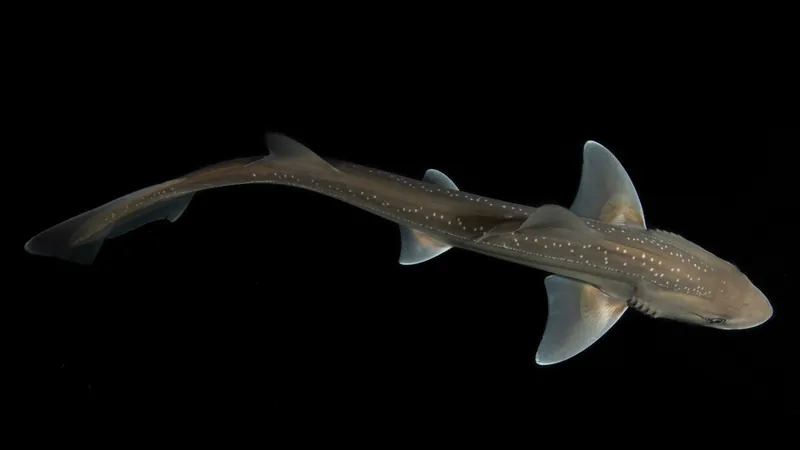
Groundbreaking Discovery: Sharks Can Communicate Through Sound!
2025-03-26
Author: Jia
For years, scientists have believed that sharks were mute creatures, relying solely on their stealth and acute senses to navigate their underwater world. A surprising new discovery has shattered this long-held belief, revealing that sharks can, in fact, produce sounds – a revelation that could change our understanding of these majestic marine predators.
Researchers at the University of Auckland's Leigh Marine Laboratory observed juvenile rig sharks (Mustelus lenticulatus), small bottom-dwellers native to New Zealand, making distinct clicking noises when they were handled underwater. These audible sounds, first recorded during routine behavioral studies, were consistent across multiple individuals and are believed to be linked to stress or defensive behavior, as detailed in a study published in the journal Royal Society Open Science.
This is the first documented instance of sharks actively producing sound. According to Carolin Nieder, the lead author of the study and a researcher at the Woods Hole Oceanographic Institution, their findings suggest that sharks may have a broader communication toolkit than previously thought. "We've often underestimated the role of sound in their behavior," Nieder explained. "Their other sensory abilities, like electroreception and smell, are finely tuned, but sound is also likely playing a critical role."
During the experiments, ten juvenile rig sharks were accidently found to emit clicks when briefly handled. These sounds were most pronounced during initial interactions, but diminished over time, leading researchers to speculate that as the sharks acclimated, they may have felt less threatened. In their natural habitat, such loud clicking could serve as a quick distraction, allowing juvenile sharks to escape predators.
This finding poses intriguing questions about shark locomotion and communication. Traditionally, it was thought sharks were silent due to the absence of swim bladders, the air-filled sacs many fish use to create sounds. However, microCT scans of the rig sharks didn’t show any obvious sound-producing organs. The research team hypothesized that the noise could arise from the sharks snapping their unique, plate-like teeth, which are effective for crushing hard-shelled prey like crustaceans.
Each click reportedly lasted around 48 milliseconds, reaching volumes comparable to a shotgun blast, with some clicks exceeding 155 decibels. These sounds varied in nature, including single bursts and short double-clicks, with some occurring without any apparent movement, raising further questions about their purpose.
Although the rig sharks’ hearing range is predominantly below 1 kilohertz—much lower than the frequencies of their clicks—it remains unclear whether these sounds are intended for communication among sharks. Predators such as New Zealand fur seals, who are known to detect higher frequencies, may react to the clicks, potentially offering juvenile sharks a tactical advantage against predation.
Furthermore, relatives of sharks, such as rays and skates, are known to produce distress sounds, indicating a possible evolutionary trait that supports communication among marine species.
Looking ahead, researchers plan to study closely related shark species to uncover the potential for sound production and what it may indicate about their responses to stress. Adrian Gutteridge, a shark biologist with the IUCN Shark Specialist Group, cautioned that more research will be essential to decipher the meaning behind these clicks. "Determining whether these sounds serve as a warning or are merely incidental is crucial for understanding their behavioral ecology," he stated.
As marine scientists delve deeper into the aquatic world of sharks, we can anticipate more exciting findings that may alter our perceptions of these enigmatic ocean dwellers and their communications. Could this discovery be the first step toward unveiling a new layer of shark behavior? Only time will tell!



 Brasil (PT)
Brasil (PT)
 Canada (EN)
Canada (EN)
 Chile (ES)
Chile (ES)
 Česko (CS)
Česko (CS)
 대한민국 (KO)
대한민국 (KO)
 España (ES)
España (ES)
 France (FR)
France (FR)
 Hong Kong (EN)
Hong Kong (EN)
 Italia (IT)
Italia (IT)
 日本 (JA)
日本 (JA)
 Magyarország (HU)
Magyarország (HU)
 Norge (NO)
Norge (NO)
 Polska (PL)
Polska (PL)
 Schweiz (DE)
Schweiz (DE)
 Singapore (EN)
Singapore (EN)
 Sverige (SV)
Sverige (SV)
 Suomi (FI)
Suomi (FI)
 Türkiye (TR)
Türkiye (TR)
 الإمارات العربية المتحدة (AR)
الإمارات العربية المتحدة (AR)